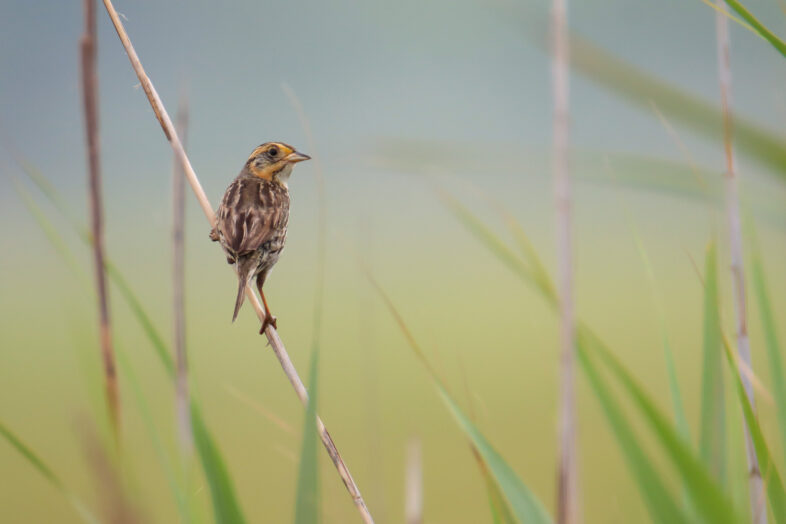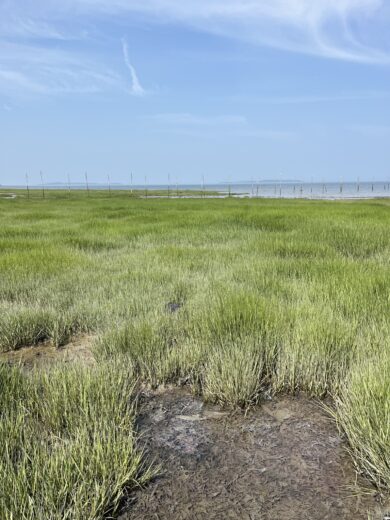
Saltmarsh Sparrow © Sean Salazar (iNaturalist user, CC-BY-NC)
New England is getting smaller each year—not in a quaint “where everybody knows your name” kind of way. The sea is rising. If you have been vacationing off-planet for the last half-century, you may have missed this news, but it will be hard to ignore moving forward…or should I say…moving up. As global temperatures rise, oceans warm and thermally expand, and icebergs and glaciers melt faster, resulting in sea level rise. The last two years (2021 and 2022) have seen the warmest years on record for the sea surface temperature in the Gulf of Maine, where sea temperatures are 3.72 °F warmer than the long-term average (Gulf of Maine Research Institute). On top of that, the Gulf of Maine sea surface temperatures are rising faster than at least 97% of the world’s oceans due to the Gulf’s shape and shallow depth and configuration of two major ocean currents (Gulf of Maine Research Institute). As the Gulf of Maine heats up, sea levels are rising there at an accelerating pace. Over the last half-century, Maine’s sea level rose about six inches, but it is predicted to rise another 1.5 feet by 2050 and almost 4 feet by 2100 (NOAA; Maine Climate Council).
Economists predict a price tag of billions of dollars to protect our coastal New England human communities from sea level rise; however, the cost to our coastal ecosystems and wildlife communities could be unmeasurable and irrecoverable. Coastal ecosystems within and near estuaries, tidal marshes, dunes, seagrass beds, and dry beaches (above mean high tide) are particularly vulnerable in New England and globally due to increased storm surges, flooding, and erosion associated with sea level rise. The Maine Climate Council predicts that sea level rise by 2050 could reduce 43% of Maine’s dry beach area and submerge 67% of Maine’s sand dunes (where sea turtles, terns, Piping Plovers (Charadrius melodus), Diamondback Terrapin (Malaclemys terrapin) and other species nest). In some areas, nearly a quarter of our salt marshes could also be lost to sea level rise by 2050 (State of the Coast Report, Trustees of Reservations). The threat to our salt marshes comes as no surprise to me—someone who conducted their Master’s research studying the post-fledging ecology of the Saltmarsh Sparrow (Ammospiza caudacuta) on the Long Island Sound.
The Saltmarsh Sparrow is an endemic tidal marsh specialist of the U.S. Atlantic Coast, and it may become the first species we lose directly to sea level rise. Salt marshes are incredibly productive tidal grasslands that are slightly flooded each day by high tides. They are home to numerous salt marsh specialist nesting bird species, including the Willet (Tringa semipalmata), Clapper Rail (Rallus crepitans), and the Seaside Sparrow (Ammospiza maritime), not to mention an incredible number of fish and invertebrate species. Saltmarsh Sparrows have evolved to take advantage of this rich ecosystem by nesting between the highest high tides each lunar cycle (a 28-day period) during the summer months. Incredibly, these sparrows weave their nests out of grass on the ground (very few shrubs can survive in this salt-rich habitat), and nestlings can even tread water when the nest lightly floods.

Saltmarsh Cordgrass © clarasurp (iNaturalist user, CC-BY-NC)
We already know that marsh sparrows are vulnerable to rising water levels. The Dusky Seaside Sparrow (Ammospiza maritima nigrescens) was a non-migratory endemic subspecies that formerly inhabited the salt marshes around the Kennedy Space Center on Merritt Island, Florida. As the space race heated up in the 1950s, NASA began purchasing land (including extensive salt marshes) on Merritt Island and the adjacent Cape Canaveral. To control mosquito populations around the rapidly expanding space complexes, the now-illegal pesticide DDT was used extensively, and the salt marshes were impounded and ditched. Impounding salt marshes allowed them to be intentionally flooded at regular intervals to interfere with the breeding cycle of the Eastern Salt Marsh Mosquito (Aedes sollicitans) and other salt marsh mosquito species that won’t lay their eggs on standing water. The regularly-spaced parallel ditching was thought to drain and dry out marshes faster in between tides, further reducing the quality of the breeding habitat for salt marsh mosquito species. Unfortunately, scientists have since documented that all of these practices resulted in disastrous consequences for salt marsh ecosystems…and they largely did not work to control mosquito populations. Note–virtually all of New England’s salt marshes are also ditched. The anthropogenic flooding and disruption of natural ecological processes within these salt marshes had unintended, severe consequences for the Dusky Seaside Sparrow population—it caused their extinction over the subsequent decades.
Human-induced flooding caused the extinction of the Dusky Seaside Sparrow—might rising sea levels result in a similar fate for Saltmarsh Sparrows? Would salt marshes remain dry enough, long enough for Saltmarsh Sparrow nestlings to fledge before they drowned under the rising seas? To find out, I teamed up with Chris Field (University of Maryland) and colleagues. We constructed a giant mathematical model that incorporated sea level rise, accretion (deposition of new substrate material), tidal cycles, and the nesting biology of the Saltmarsh Sparrow—which has declined by a staggering 87% since 1998 (U.S. Fish and Wildlife Service). Under a moderate sea level rise projection, we predicted that sea level rise will make most salt marshes unsuitable for nesting Saltmarsh Sparrows by 2035—their nests simply won’t be above water long enough for the young to survive over their 23-day nesting cycle. Sadly, we forecast that the species will likely become extinct before 2060—a sobering prediction.
Salt marshes cannot just move up into the landscape like a child playfully runs from a small wave crashing on the beach because salt marshes are restricted…they are surrounded. Salt marshes are typically bordered on the upland side by roads (e.g., Highway 1, AKA Boston Post Road) and other infrastructure, tidal gates and barriers, and very expensive commercial and residential properties with sea walls and drainage culverts. Tidal marshes won’t simply move up into the landscape as sea levels rise—they’ll just become submerged, like some kind of watery memorial for one of our most specialized bird species. Simultaneously, New England will become a smaller, less biologically diverse place, with one less name to know.
